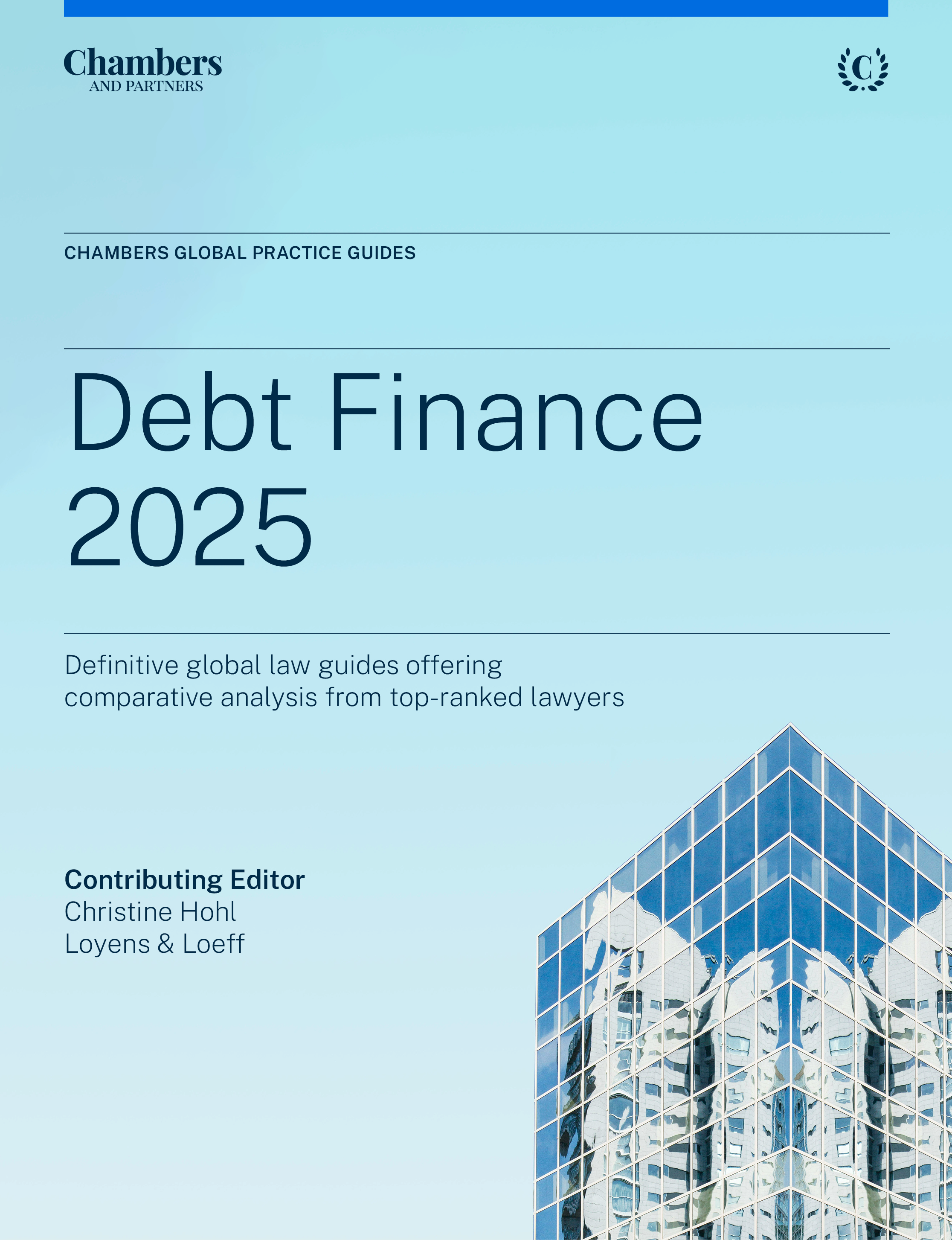
Debt Finance 2025
The Debt Finance 2025 guide covers key global jurisdictions. The guide provides the latest legal information on debt finance markets, debt finance transactions and structuring, the documentation involved, guarantees and security, intercreditor issues, enforcement, lenders’ rights in insolvency, and tax and regulatory considerations.
Last Updated: April 29, 2025
Compare law and practice by selecting locations and topic(s)
Select Locations

Select Topic(s)

Please select at least one location and one topic to use the compare functionality.
Navigating the Dynamics of Global Debt Finance Markets
This Practice Guide focuses on key topics in debt finance. Legal practitioners from various jurisdictions will analyse both law and practice and trends and developments in the debt finance market in their home country.
Market overview and key trends in 2024
Debt finance markets in both Europe and the United States have undergone significant changes over the past year. The economic climate of 2024, characterised by fluctuating interest rates, the relief of inflationary pressures and an evolving regulatory landscape, has impacted market dynamics. Borrowers have sought to take advantage of the temporary stability in borrowing costs to restructure debt, while lenders have recalibrated their risk assessments, often tightening lending terms in response to macroeconomic and geopolitical uncertainty.
One significant trend in 2024 has been the dramatic increase in leveraged loan issuances. In the United States, issuance volumes have surged, reaching nearly USD902.5 billion by mid-year, a stark contrast to the USD461 billion recorded in the same period in 2023. A similar trend has been observed in Europe, where leveraged loan issuances climbed to USD180.4 billion. The resurgence of leveraged lending has been primarily driven by refinancing activity, as borrowers take proactive steps to address upcoming maturities and optimise capital structures. This also reflects cautious optimism that financing conditions will remain favourable, at least in the short term. However, challenges remain, particularly as investors continue to scrutinise borrowers’ credit quality, leading to increased differentiation in pricing and covenant structures across different sectors and credit ratings.
Private credit and direct lending have also continued their rapid ascent, with institutional investors allocating record amounts of capital to non-bank lending platforms. The expansion of private credit has not only provided borrowers with alternative sources of funding but has also introduced new complexities into debt finance transactions. Direct lenders, unlike traditional banks, often provide bespoke financing arrangements that incorporate greater flexibility but also demand enhanced lender protections. The rise of unitranche financing, where senior and junior debt are consolidated into a single facility, has been particularly notable, offering borrowers easier access to capital while providing lenders with enhanced security packages.
Another key trend has been the increasing reliance on asset-based lending (ABL), particularly among mid-market borrowers and those facing liquidity constraints. ABL, which relies on collateral such as receivables, inventory and equipment, is also attractive to lenders seeking to mitigate credit risk amid economic uncertainty. Asset-heaving businesses in sectors such as manufacturing, retail and transportation have found ABL structures more favourable than traditional term loans.
The structured finance market has also seen a resurgence, with renewed demand for collateralised loan obligations (CLOs) and asset-backed securities (ABS). Institutional investors in particular have been drawn to these instruments due to their ability to offer diversification and risk-adjusted returns, despite ongoing concerns about credit quality and the potential for regulatory intervention.
In Europe at least, sustainability-linked loans and green bonds have become an integral part of the financing strategy of many companies. Borrowers with strong ESG credentials have been able to secure financing on preferential terms, benefiting from lower interest rates tied to key performance indicators related to environmental and social impact. At the same time, scrutiny of ESG-related financing has intensified.
2025 outlook
Looking ahead to 2025, the debt finance markets remains at an inflection point. The interplay between regulatory developments, geopolitical and macroeconomic factors and corresponding shifts in investor sentiment will continue to shape global financing activity. Lenders are expected to place greater emphasis on structural protections while borrowers will need to navigate increasingly complex compliance and reporting obligations as well as uncertain, and at times conflicting, policy directions. Against this backdrop, legal practitioners can play an important role in structuring transactions that balance the need for flexibility for borrowers with adequate risk mitigation for lenders.
Liability management exercises and other debt restructuring strategies are expected to remain prominent as significant debt maturities are approaching and borrowers need to continue to raise debt capital in the absence of unencumbered assets.
In somewhat of a counter-development, the strengthening of protective covenants in loan documentation is also expected to be a defining trend. In contrast to the pre-pandemic era, when covenant-lite structures became the norm, lenders are increasingly demanding stronger safeguards, ranging from maintenance covenants and stricter leverage ratios to enhanced reporting requirements. While top-tier borrowers may still be spared, weaker credits are likely to face more restrictive lending conditions, reflecting heightened lender caution in a more uncertain economic environment.
Macroeconomic and geopolitical factors will also have a direct impact on borrowing costs and capital market performance. In the context of heightened political tensions and increased defence spending, global sovereign debts are expected to reach an unprecedented level of USD12.3 trillion in 2025, leading to concerns about market liquidity and broader economic stability.
Regulatory developments
US regulatory landscape
In the United States, regulators intensified their focus on leveraged lending, private credit and structured finance markets. The Securities and Exchange Commission (SEC) expanded its oversight of private credit funds, examining risk management practices and transparency standards. As private credit plays a growing role in corporate finance, regulators are evaluating whether additional disclosure obligations should be imposed on direct lenders to ensure market stability.
The Federal Reserve and the Office of the Comptroller of the Currency also revisited leveraged lending guidelines. While the 2013 interagency guidance remains the regulatory benchmark, financial regulators have expressed concerns over relaxed underwriting standards, increasing leverage rations and covenant-light loan structures. Banks involved in underwriting secured loans are now subject to heightened scrutiny regarding risk assessment and stress testing.
The proposed implementation of the Basel III endgame reforms would require US banks to hold additional capital against higher-risk exposures. This change could impact the availability of debt financing by making it more costly for banks to extend credit. If banks scale back their lending activities due to these capital requirements, private credit funds may absorb a greater share of the market, shifting risk outside the regulated banking system.
CLOs are also under regulatory review. The SEC has been assessing whether increased disclosure requirements should be imposed on CLO managers to enhance market transparency. Given the CLO market’s significant role in leveraged loan financing, regulatory changes in this area could have a ripple effect.
It remains to be seen what impact the Trump administration will have on the aforementioned regulatory initiatives following the customary regulatory moratorium. Certain of the final Basel III endgame rules are expected to be delayed until 2026, and the required capital increases may well be limited to a few percentage points.
In addition, restrictions on bank consolidations are expected to be eased, and crypto legislation is anticipated to gain bipartisan support.
European regulatory developments
In Europe, regulatory efforts have focused on strengthening banks’ resilience, increasing transparency in leveraged lending and integrating ESG considerations into financing transactions. The European Central Bank (ECB) has raised concerns about weakening lending standards and growing exposure to highly leveraged borrowers. In 2024, the ECB conducted a review of leveraged lending practices, identifying risks associated with covenant-light structures and rising corporate debt levels. As a result, banks are expected to adopt a more conservative lending approach in 2025.
The finalisation of the Basel III endgame rules in Europe was expected in 2025; however, further delays and changes are now anticipated following the Bank of England’s decision to postpone implementation in the UK until 1 January 2027 in order to allow more time to gain clarity on implementation in the USA, so as not to hamper competitiveness and growth opportunities in Europe. While regulators argue that the Basel III endgame measures will strengthen financial stability, some market participants worry that they may reduce credit availability for leveraged borrowers.
ESG remains a central regulatory focus in Europe, with enhanced disclosure and compliance requirements impacting how lenders assess and price risk. The Corporate Sustainability Reporting Directive (CSRD), which took effect in 2024, mandates detailed sustainability disclosures for companies engaging in ESG-linked borrowing. Lenders are now required to ensure that sustainability metrics are clearly defined and verifiable, adding another layer of complexity to financing arrangements.
The European Banking Authority has also expanded ESG risk management requirements, such that banks must incorporate climate-related risks into their credit assessments. These changes affect lending terms as lenders must now factor in environmental risks when evaluating collateral quality and borrower creditworthiness. Borrowers that fail to meet sustainability criteria may face higher borrowing costs or restricted access to financing.
Cross-border regulatory challenges
The divergence between US and European regulatory approaches presents additional challenges for cross-border debt financing. Companies and financial institutions operating in both jurisdictions must navigate differing capital requirements, leveraged lending guidelines and disclosure obligations.
One significant challenge is the regulatory treatment of non-bank lenders. In the USA, private credit funds operate with fewer restrictions compared to traditional banks, allowing them greater flexibility to structure financing arrangements. However, European regulators are increasingly scrutinising the role of non-bank lenders, with the European Systemic Risk Board recommending a review of regulatory frameworks governing private credit. Any new oversight measures could impact direct lending activity in Europe.
Disparity in ESG regulation also complicates cross-border financings. While both the USA and Europe have introduced sustainability disclosure rules, European regulations – particularly the CSRD – are significantly more detailed and prescriptive. Companies issuing ESG-linked debt across both jurisdictions must comply with different regulatory standards. Financial institutions involved in sustainability-linked financing must ensure that reporting frameworks align with both US and European requirements.
These regulatory disparities are expected to increase further in light of the anti-ESG agenda and anticipated wider de-regulation under the Trump administration.
This guide aims to provide the reader with an insight into the economic and regulatory environment in which the debt finance market operates in the covered jurisdictions but also to offer practical guidance on how debt finance transactions are being conducted in these countries at a more granular level. The authors hope you find it both useful and interesting.

